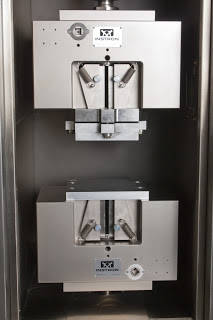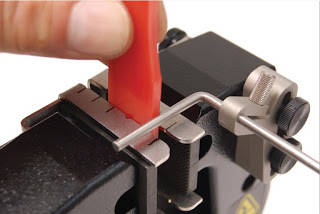When testing stiff or brittle materials, such as composites, alignment is crucial—even instances of slight misalignment can throw off test results.
Misalignment in test frames takes two forms: concentricity misalignment, where the centerline of the upper grip/fixture is offset from the centerline of the lower grip/fixture, and angularity misalignment, where the two centerlines are at contrasting angles. Both forms cause extra stress on the specimen and can affect mechanical properties such as modulus, maximum elongation, and tensile strength.
The alignment of a system is so critical to test results that organizations, such as Nadcap, strictly regulate misalignment. To meet these requirements and reach the most accurate results, the test operator needs to carefully assess his or her station, including the testing frame itself to the alignment cells used to verify alignment.
In addition to being accurately aligned, the frame should also be stiff so that it deflects very little at the load.
Next, it’s necessary to align the frame with the grips that will actually be used. This means that if an alignment is performed with one set of grips, but then replaced with a second set of grips, both sets of grips must be realigned. (To prevent removing grips, it is helpful to choose grips that can accommodate multiple tests including compression).

Rigid and symmetrical grips produce the best alignment results. Under load, symmetrical grips will deform symmetrically from front-to-back/from side-to-side; therefore, the grips will not bend the specimen. Plus, the more rigid a grip is the less it will deform under load.
Once the frame and grips are aligned, now the specimen needs to be aligned. The operator oversees this process. To minimize user error, grips with specimen stops indicate where to place the specimen every time. If the specimen is loaded in different positions, even in a perfectly aligned system, large variation will occur.

To ensure that platens are parallel to the degree that Nadcap requires, one rigid platen and one locking, spherically-seated platen are required. These types of platen can be compressed against each other to ensure that they are parallel and can then be locked to prevent them from being misaligned.
Alignment cells are an essential part of any alignment. These cells, when used in conjunction with software, provide valuable information on how to correct a system’s misalignment. The dimensions of the cell should be as close as possible to the specimens being tested. On occasion, standard or stock alignment cells do not fit with the samples being tested. In these instances, the design of a custom strain-gaged alignment cell may be necessary. Since fabricating a strain-gaged alignment transducer can be a time-consuming process, plan this step well in advance.
Any given system has small misalignment errors due to tolerances of the frame and the parts used. To adjust for these small errors, it is helpful to have a fixture which can be used to make small adjustments to the concentricity and angularity of the load string. This is especially handy for future alignments and will save you time and effort down the road.
As always, feel free to contact us with any questions.